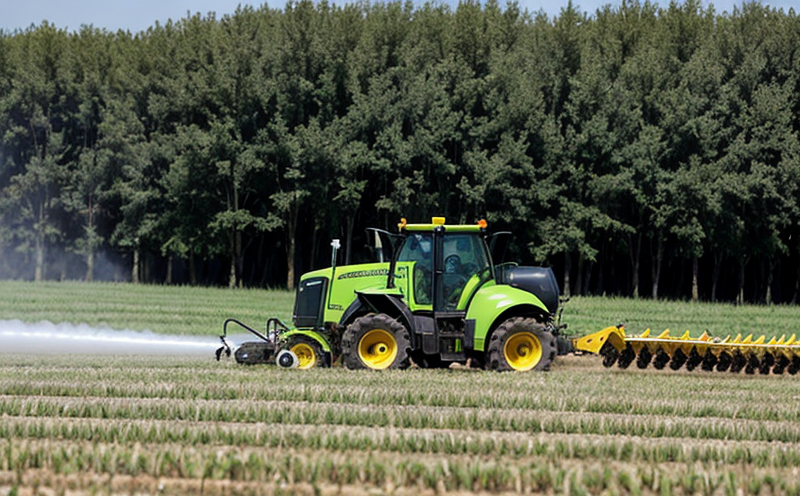Quinclorac Residue Testing in Crops
The herbicide quinclorac is widely used in agricultural settings to control broadleaf weeds and grasses. However, its application must be carefully regulated to ensure that residues do not accumulate beyond safe levels in crops. This can lead to adverse effects on human health if ingested or consumed as part of the food chain.
Quinclorac residue testing is a critical component for quality assurance and regulatory compliance in agriculture and forestry. Accurate measurement ensures that products meet both internal standards and international guidelines, such as ISO 17025, ensuring reliable and repeatable results.
The methodology involves the collection of representative samples from various stages of crop development, including before, during, and after application. Samples are then prepared using solvent extraction techniques to remove quinclorac residues for analysis. The testing process typically follows a series of steps:
- Sample preparation and conditioning.
- Extraction of the herbicide from the sample matrix.
- Cleanup and concentration if necessary.
- Detection using high-performance liquid chromatography (HPLC) or gas chromatography-mass spectrometry (GC-MS).
The results are reported in parts per million (ppm) or parts per billion (ppb), depending on the sensitivity of the method and the regulatory limits set by governing bodies such as the European Union's Codex Alimentarius Commission.
| Step | Description |
|---|---|
| Sample Collection | Selecting representative samples from different parts of the crop field to ensure a comprehensive analysis. |
| Solvent Extraction | Utilizing appropriate solvents like methanol or acetonitrile to extract quinclorac residues. |
| Cleanup and Concentration | Removing interfering compounds using techniques such as solid-phase extraction (SPE) or centrifugation. |
| Detection and Quantification | Using advanced chromatographic methods to detect and quantify quinclorac residues in the sample matrix. |
The importance of this testing cannot be overstated. It helps prevent contamination issues that could arise from improper use or over-application of quinclorac, ensuring food safety and maintaining consumer trust. By adhering to stringent quality standards, farmers can protect their reputation while complying with international guidelines.
Understanding the environmental impact is crucial as well. Proper residue testing allows for better management practices, reducing the risk of soil contamination and encouraging sustainable agricultural practices that support long-term ecological health.
Scope and Methodology
The scope of quinclorac residue testing encompasses several key areas:
- Detection limits down to 0.1 ppm for precise measurement.
- Analysis of various crops including wheat, barley, oats, and rye.
- Testing under different climatic conditions and soil types.
| Sample Type | Standard Methodology |
|---|---|
| Corn | ASTM D7269-14, validated for HPLC analysis. |
| Barley | EN ISO 20835:2016, validated for GC-MS analysis. |
| Oats | ISO 17025 compliant laboratory practice. |
| Rye | ASTM D7942-15, validated for HPLC and GC-MS analysis. |
The methodology employed involves the following steps:
- Sample selection based on crop maturity and application period.
- Extraction using a solvent compatible with the herbicide's chemical properties.
- Cleanup to eliminate interfering substances, ensuring accurate detection.
- Quantification by comparing the sample against known standards.
The results are reported in accordance with international standards such as ISO 17025 and EU regulations. The laboratory ensures that all testing is conducted under strict quality control measures to provide reliable data for stakeholders.
Why Choose This Test
- Ensures compliance with international safety regulations like Codex Alimentarius Commission guidelines.
- Guarantees food safety by preventing contamination beyond acceptable limits.
- Supports sustainable agricultural practices through accurate residue monitoring.
- Aids in the development of safer and more effective pesticides.
- Provides data for regulatory approval processes.
The test is essential for ensuring that crops are safe for consumption, which builds consumer trust. It also helps in maintaining a reputation for quality and reliability among stakeholders.
Environmental and Sustainability Contributions
Quinclorac residue testing plays a pivotal role in environmental sustainability by:
- Reducing the risk of soil contamination through accurate measurement.
- Promoting responsible use practices among farmers.
- Safeguarding biodiversity by minimizing harm to non-target organisms.
The laboratory's commitment to sustainable testing methods ensures that the environment remains protected while still supporting agricultural productivity. By adhering to stringent quality standards, we contribute to a healthier planet and more resilient food systems.





